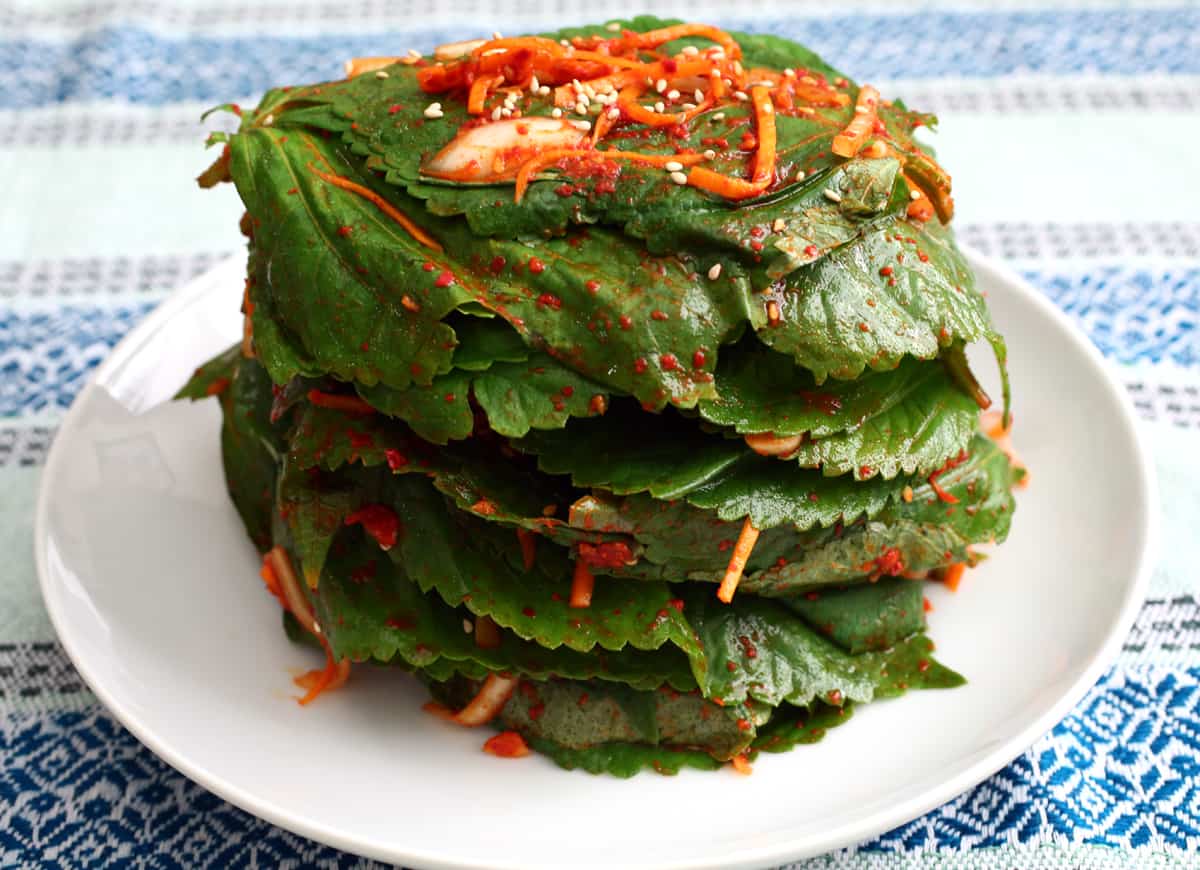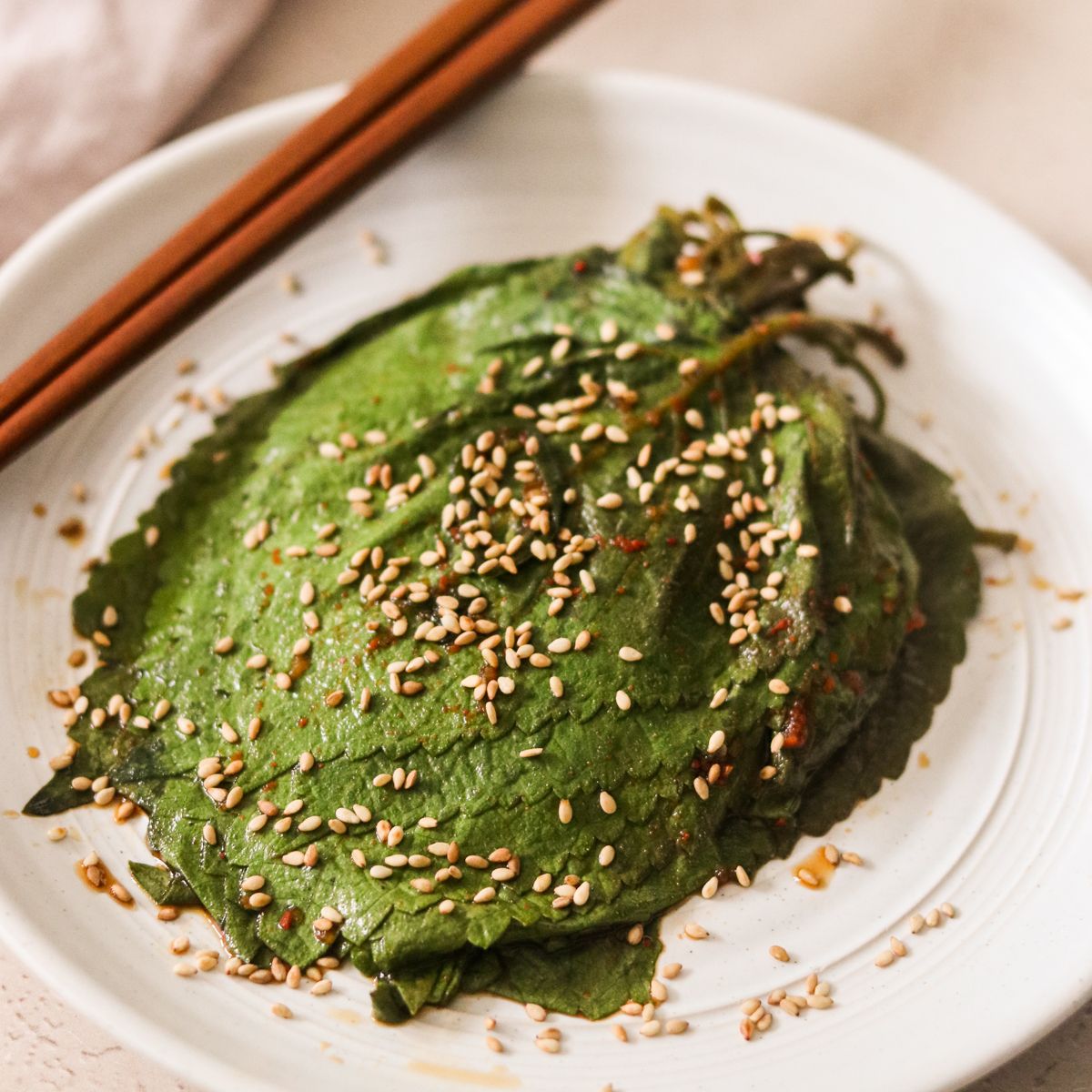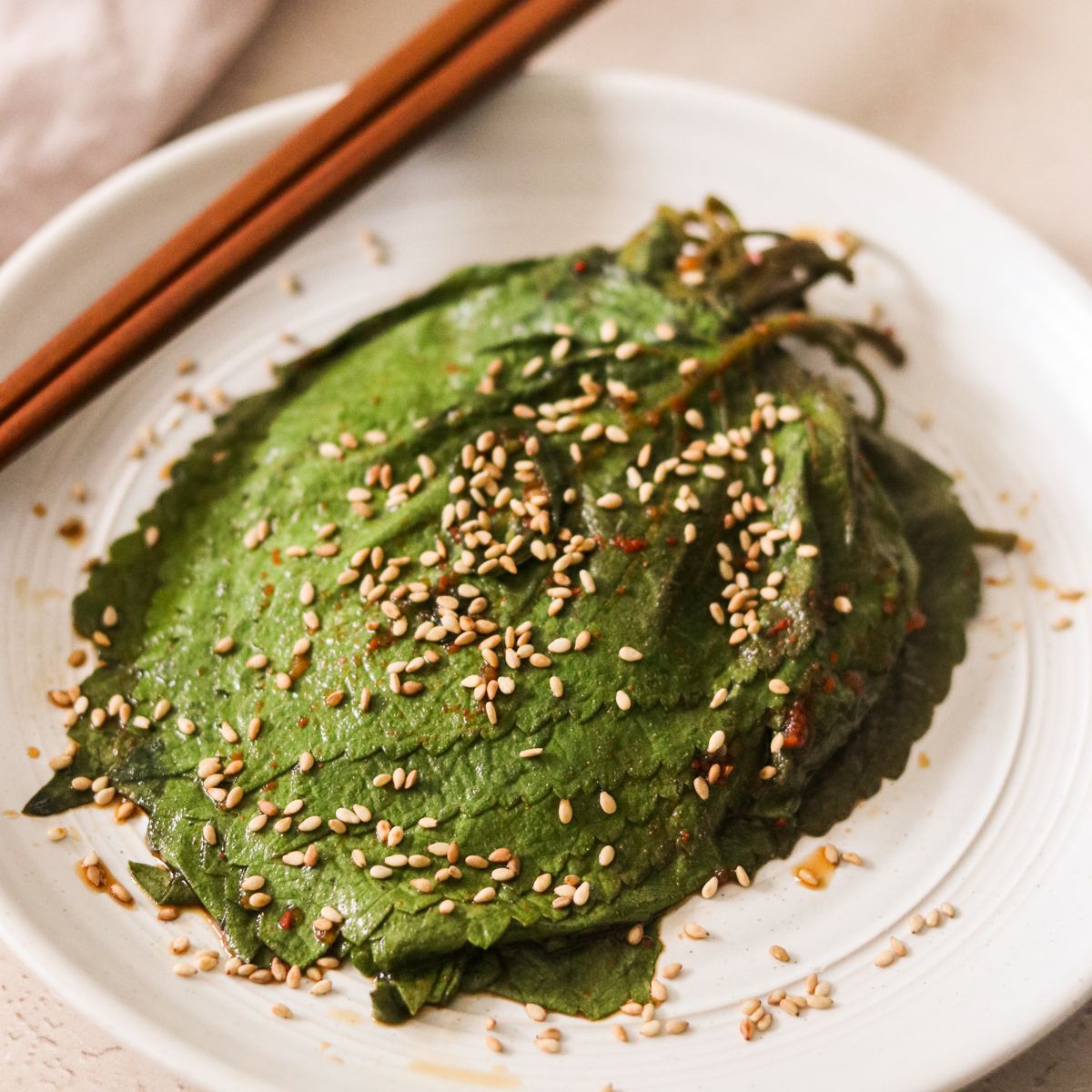Perilla Leaf Recipes: How to Incorporate This Herb into Your Cooking for Great Results – a journey into the world of this versatile and flavorful herb. Often called “shiso” in Japanese cuisine, perilla leaf offers a unique flavor profile that can elevate your dishes to new heights.
From its vibrant green hue to its aromatic, slightly minty taste, perilla leaf is a culinary gem waiting to be discovered. But its appeal extends beyond taste; this herb boasts a wealth of nutritional benefits, making it a delicious and healthy addition to your culinary repertoire.
This guide delves into the captivating world of perilla leaf, exploring its culinary uses, flavor combinations, and health benefits. We’ll uncover the secrets to incorporating this herb into your cooking, providing recipes, tips, and insights that will inspire you to experiment and create culinary masterpieces.
Introduction to Perilla Leaf

Perilla leaf, scientifically known asPerilla frutescens*, is an aromatic herb native to East Asia, particularly China, Japan, and Korea. It has been a staple ingredient in Asian cuisine for centuries, adding a unique and complex flavor profile to dishes.
Perilla leaf boasts a distinctive flavor that combines elements of mint, basil, and citrus, making it a versatile ingredient for both savory and sweet dishes. Its versatility shines in various culinary applications, from adding a vibrant punch to salads and stir-fries to infusing a unique aroma in sauces and marinades.
Nutritional Benefits of Perilla Leaf
Perilla leaf is not only a culinary delight but also a nutritional powerhouse. It is rich in antioxidants, particularly rosmarinic acid, which has been shown to possess anti-inflammatory and anti-allergic properties. Perilla leaf is also a good source of vitamins A and C, essential for maintaining healthy skin and boosting the immune system.
Culinary Uses of Perilla Leaf
Perilla leaf, also known as shiso, is a versatile herb that has been used in Asian cuisine for centuries. It has a unique flavor profile that combines elements of mint, basil, and citrus, making it a perfect addition to a variety of dishes.
From salads and soups to meat and fish, perilla leaf can add a burst of flavor and aroma to any meal.
Popular Perilla Leaf Recipes
Perilla leaf is a popular ingredient in many Asian cuisines, including Korean, Japanese, and Chinese. It is used in a variety of dishes, from simple salads to complex stir-fries. Here are some popular perilla leaf recipes from around the world:
Recipe Name |
Cuisine |
Ingredients |
Preparation |
|---|---|---|---|
Bibimbap |
Korean |
Rice, vegetables, meat, perilla leaf, gochujang (Korean chili paste) |
Combine all ingredients in a bowl and mix well. |
Sashimi |
Japanese |
Raw fish, perilla leaf, soy sauce, wasabi |
Arrange the sashimi on a plate and garnish with perilla leaf. |
Kung Pao Chicken |
Chinese |
Chicken, peanuts, vegetables, perilla leaf, chili peppers, soy sauce |
Stir-fry the chicken, peanuts, and vegetables. Add the perilla leaf and chili peppers and cook until heated through. |
Perilla Leaf Salad |
Various |
Perilla leaf, lettuce, cucumber, tomatoes, sesame oil, soy sauce |
Combine all ingredients in a bowl and toss to coat. |
Perilla Leaf in Traditional Korean Cuisine
In Korean cuisine, perilla leaf is known as kkaennipand is commonly used as a garnish, flavoring agent, and ingredient in various dishes. It is particularly popular in bibimbap, a mixed rice dish with vegetables, meat, and a fried egg. The perilla leaf adds a refreshing and slightly spicy flavor to the dish.
Perilla Leaf in Traditional Japanese Cuisine
In Japanese cuisine, perilla leaf is known as shisoand is used in a variety of dishes, including sashimi, sushi, and tempura. The leaves are often used as a garnish or wrapped around ingredients to impart a unique flavor and aroma.
Perilla leaf, with its vibrant flavor and versatility, adds a unique touch to any dish. From stir-fries to salads, its peppery notes and earthy aroma can transform a simple meal into something extraordinary. And while you’re enjoying the flavors of fall, why not embrace the season’s beauty with a stunning autumn leaf garland?
Add Warmth to Your Home with a Beautiful Autumn Leaf Garland – Easy Steps Here! Once your home is adorned with the season’s colors, you can continue exploring the culinary world of perilla leaf. Experiment with its unique flavor in marinades, soups, and even desserts to discover a new level of flavor in your fall recipes.
Shiso is also used in making shiso picklesand shiso tea.
Perilla Leaf in Traditional Chinese Cuisine
In Chinese cuisine, perilla leaf is known as suancaoand is used in a variety of dishes, including Kung Pao Chicken, Mapo Tofu, and stir-fries. The leaves are often added at the end of cooking to preserve their flavor and aroma. Suancao is also used in making perilla leaf teaand perilla leaf oil.
Incorporating Perilla Leaf into Your Cooking: Perilla Leaf Recipes: How To Incorporate This Herb Into Your Cooking For Great Results
Perilla leaf, with its unique flavor and versatility, can elevate your culinary creations. Whether you’re looking to add a fresh, minty twist to salads or a smoky, savory note to stir-fries, perilla leaf can be a welcome addition to your kitchen.
Perilla leaf, with its vibrant color and unique flavor, is a versatile herb that can add a delightful twist to many dishes. While its peppery notes may be reminiscent of shiso, perilla offers a more complex flavor profile. For those seeking to explore similar citrusy notes in their cooking, consider exploring the aromatic world of Kaffir Lime Leaf in Your Kitchen: How to Add Zesty Flavor to Your Meals.
Both perilla and kaffir lime leaf bring a distinct character to dishes, making them perfect for experimenting with new culinary combinations.
Using Perilla Leaf in Various Dishes
Perilla leaf can be used in various ways to enhance the flavor and aroma of your dishes.
- Salads:Perilla leaf adds a refreshing, slightly minty and peppery note to salads. You can use it as a garnish or chop it finely and mix it with other greens. It complements leafy greens like lettuce, spinach, and arugula, as well as vegetables like cucumbers, tomatoes, and bell peppers.
- Stir-fries:Adding perilla leaf towards the end of cooking helps retain its vibrant color and flavor. It pairs well with meats like chicken, pork, and tofu, as well as vegetables like mushrooms, broccoli, and carrots.
- Soups:Perilla leaf can be added to soups for a unique and fragrant flavor. It’s particularly well-suited for clear broths and miso soups. You can add it towards the end of cooking for a fresh flavor or simmer it for a more intense, herbal taste.
- Marinades:Perilla leaf can be used to create flavorful marinades for meat, poultry, and fish. Its distinct flavor adds a unique dimension to grilled, roasted, or pan-fried dishes.
Tips for Preparing Perilla Leaf
Proper preparation and storage are key to maximizing the flavor and freshness of perilla leaf.
- Storage:Store perilla leaf in a plastic bag in the refrigerator for up to 5 days. To preserve its freshness, you can also wash and dry the leaves thoroughly before storing them.
- Cleaning:Rinse perilla leaves thoroughly under cold water to remove any dirt or debris. Pat them dry with a paper towel or salad spinner.
- Flavor Enhancement:For a more pronounced flavor, you can lightly bruise the leaves before using them.
- Heat Sensitivity:Perilla leaf is sensitive to heat, so add it towards the end of cooking to preserve its flavor and color.
Perilla Leaf Usage Guide
Dish Type |
Perilla Leaf Usage |
Flavor Enhancement |
Additional Tips |
|---|---|---|---|
Salads |
Garnish, finely chopped, or mixed with other greens |
Adds a refreshing, minty, and peppery note |
Pair with leafy greens, cucumbers, tomatoes, and bell peppers |
Stir-fries |
Added towards the end of cooking |
Enhances the savory flavors of meats and vegetables |
Pair with chicken, pork, tofu, mushrooms, broccoli, and carrots |
Soups |
Added towards the end of cooking or simmered for a more intense flavor |
Adds a unique, fragrant flavor, especially to clear broths and miso soups |
Use fresh or dried leaves, depending on the desired flavor intensity |
Marinades |
Chopped and added to marinades |
Adds a distinct, savory flavor to grilled, roasted, or pan-fried dishes |
Pair with meats, poultry, and fish |
Flavor Combinations and Pairings
Perilla leaf’s unique flavor profile opens up a world of possibilities for culinary pairings. Its versatility allows it to be used in a variety of dishes, enhancing their flavor and texture. This section explores the best flavor combinations and pairings for perilla leaf, highlighting its complementary nature with various ingredients.
Flavor Pairings
Perilla leaf’s distinctive flavor, often described as a blend of mint, basil, and citrus, makes it a perfect companion for a variety of ingredients. Its subtle anise and peppery notes complement dishes with strong, savory flavors, while its refreshing quality adds a touch of brightness.
Here are some of the most common and complementary flavor pairings for perilla leaf:
- Sesame:The nutty and slightly sweet flavor of sesame seeds creates a harmonious balance with perilla leaf’s earthy and peppery notes. This pairing is often seen in Korean cuisine, where perilla leaves are used to wrap grilled meats and vegetables with sesame oil and salt.
- Ginger:The spicy and pungent flavor of ginger complements the refreshing and slightly citrusy notes of perilla leaf. This pairing is popular in Asian cuisine, where perilla leaves are often used in stir-fries and noodle dishes with ginger.
- Garlic:The strong, savory flavor of garlic enhances the earthy and peppery notes of perilla leaf. This combination is often used in Korean and Japanese cuisine, where perilla leaves are added to stir-fries, soups, and stews with garlic.
- Chili:The heat of chili peppers contrasts with the refreshing and slightly citrusy notes of perilla leaf, creating a complex and flavorful combination. This pairing is popular in Thai and Vietnamese cuisine, where perilla leaves are used in curries, salads, and noodle dishes with chili peppers.
Comparison with Other Herbs
Perilla leaf’s flavor profile is often compared to other popular herbs, such as basil, mint, and cilantro. While sharing some similarities, perilla leaf offers a distinct and unique flavor that sets it apart.
- Basil:Both perilla leaf and basil have a slightly sweet and slightly peppery flavor, but perilla leaf has a more pronounced anise and citrus note. Basil is typically used in Italian and Mediterranean cuisine, while perilla leaf is more common in Asian cuisine.
- Mint:Perilla leaf and mint both have a refreshing and slightly cooling flavor, but perilla leaf has a more complex flavor profile with hints of anise and citrus. Mint is often used in Middle Eastern and Indian cuisine, while perilla leaf is more common in Asian cuisine.
- Cilantro:Both perilla leaf and cilantro have a slightly citrusy flavor, but perilla leaf has a more pronounced anise and peppery note. Cilantro is often used in Mexican and Southeast Asian cuisine, while perilla leaf is more common in East Asian cuisine.
Dishes that Benefit from Perilla Leaf
Perilla leaf’s versatility and unique flavor profile make it a valuable addition to a wide range of dishes. Its ability to enhance flavor and texture makes it a perfect ingredient for:
- Salads:Perilla leaf adds a refreshing and slightly citrusy note to salads, complementing both savory and sweet ingredients.
- Stir-fries:Perilla leaf’s earthy and peppery notes enhance the flavor of stir-fries, adding a touch of complexity and depth.
- Noodle dishes:Perilla leaf’s refreshing and slightly citrusy flavor complements the savory flavors of noodle dishes, adding a touch of brightness.
- Soups:Perilla leaf’s earthy and peppery notes add depth and complexity to soups, while its refreshing quality balances the richness of broth.
- Grilled meats and vegetables:Perilla leaf’s unique flavor profile complements the smoky and charred flavors of grilled meats and vegetables, adding a touch of freshness.
- Sushi and sashimi:Perilla leaf’s refreshing and slightly citrusy flavor complements the delicate flavors of sushi and sashimi, adding a touch of brightness.
- Sauces and dressings:Perilla leaf can be used to create unique and flavorful sauces and dressings, adding a touch of complexity and depth.
Health Benefits and Considerations
Perilla leaf, beyond its culinary appeal, boasts a range of potential health benefits. Its nutritional profile and unique compounds contribute to its diverse medicinal properties. However, it’s essential to be aware of potential side effects and considerations before incorporating it into your diet.
Potential Health Benefits of Perilla Leaf
Perilla leaf consumption is linked to various health advantages, including:
- Improved Digestion:Perilla leaf contains dietary fiber, which aids in promoting regular bowel movements and preventing constipation. This fiber also helps maintain a healthy gut microbiome, crucial for overall digestive health.
- Enhanced Immunity:Perilla leaf is rich in antioxidants, which help protect cells from damage caused by free radicals. These antioxidants may contribute to a stronger immune system, potentially reducing the risk of infections and chronic diseases.
- Reduced Inflammation:Perilla leaf contains compounds with anti-inflammatory properties, which may help reduce inflammation throughout the body. This could benefit individuals with conditions like arthritis or inflammatory bowel disease.
Potential Side Effects and Allergic Reactions, Perilla Leaf Recipes: How to Incorporate This Herb into Your Cooking for Great Results
While perilla leaf is generally considered safe for consumption, some individuals may experience side effects:
- Allergic Reactions:Perilla leaf belongs to the mint family, and individuals with allergies to mint or other related herbs like basil or oregano may experience allergic reactions. Symptoms can include skin rashes, itching, swelling, and difficulty breathing. If you experience any allergic reactions, discontinue use and consult a healthcare professional.
- Gastrointestinal Issues:Consuming large amounts of perilla leaf may cause digestive discomfort, such as bloating, gas, or diarrhea, due to its high fiber content. It’s recommended to start with small amounts and gradually increase intake to allow your body to adjust.
- Interactions with Medications:Perilla leaf may interact with certain medications, such as blood thinners. If you are taking any medications, it’s crucial to consult with your doctor before incorporating perilla leaf into your diet.
Incorporating Perilla Leaf into a Balanced Diet
Perilla leaf can be a healthy addition to a balanced diet. It’s a good source of vitamins, minerals, and antioxidants.
Here are some tips for incorporating perilla leaf into your diet:
- Start with Small Amounts:Begin by adding small amounts of perilla leaf to your dishes to assess your tolerance and prevent potential digestive discomfort.
- Variety in Consumption:Experiment with different ways to consume perilla leaf, such as adding it to salads, stir-fries, soups, or using it as a garnish. This variety ensures you enjoy its unique flavor and benefit from its nutritional value.
- Moderation is Key:While perilla leaf offers health benefits, it’s important to consume it in moderation. Excessive intake may lead to side effects. Aim for a balanced approach, incorporating it into your diet alongside other nutritious foods.
Final Wrap-Up

As you venture into the realm of perilla leaf, you’ll discover a world of culinary possibilities. From the refreshing crunch of perilla leaf in salads to its bold flavor in stir-fries and soups, this herb offers a unique and delightful experience.
Its versatility allows you to experiment with different flavor combinations, creating dishes that are both delicious and nutritious. So, embrace the power of perilla leaf and embark on a culinary adventure that will tantalize your taste buds and nourish your body.
General Inquiries
What does perilla leaf taste like?
Perilla leaf has a unique flavor profile that is often described as a combination of mint, basil, and citrus. It has a slightly pungent and aromatic taste with a hint of sweetness.
Where can I buy perilla leaf?
Perilla leaf can be found at Asian grocery stores, specialty markets, and some well-stocked supermarkets. You may also be able to find it online.
How long does perilla leaf last?
Fresh perilla leaf can last for several days in the refrigerator if stored properly. Wrap it in a damp paper towel and place it in a plastic bag.
